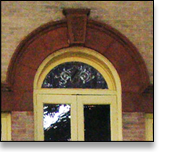The History of the Coleman House
 John Coleman, a well-known Winston-Salem tobacco buyer, built the home in 1904. According to the 1904-05 City Directory, Coleman was active in civic affairs and was a member of Home Moravian Church. He and his wife, Mary Conrad Coleman, raised four daughters and two sons in the house. The photo at the right was most likely taken when the Colemans lived there.
John Coleman, a well-known Winston-Salem tobacco buyer, built the home in 1904. According to the 1904-05 City Directory, Coleman was active in civic affairs and was a member of Home Moravian Church. He and his wife, Mary Conrad Coleman, raised four daughters and two sons in the house. The photo at the right was most likely taken when the Colemans lived there.
The house is “one of the most elaborate examples” of the Colonial Revival style in Winston-Salem, writes Gwynne Stephens Taylor in From Frontier to Factory: An Architectural History of Forsyth County.
 The book notes the home’s “central bay with a Palladian window and rubbed-brick surround.”
The book notes the home’s “central bay with a Palladian window and rubbed-brick surround.”
When the home was built, R.J. Reynolds Tobacco Co. had been making chewing tobacco for 30 years, but would not start making Camel cigarettes for another nine, in the same year Winston and Salem merged. Shamrock Hosiery Mills (forerunner of Hanesbrands) had just begun operating, making men's socks.
 And West End was quickly becoming one of the city’s most fashionable neighborhoods, attracting wealthy citizens such as Reynolds himself.
And West End was quickly becoming one of the city’s most fashionable neighborhoods, attracting wealthy citizens such as Reynolds himself.
Today, West End is a national and local historic district.
Coleman died in 1929, and in 1935 the home was bought by William Spach. His family owned the house until 1949, when Spach’s widow sold it to the Winston Lodge of the Masons.
Four years later the Masons sold the house to the Winston-Salem Foundation, which bought it with a grant from the Kate B. Reynolds Charitable Trust. For more than 50 years after that it was known as the Friendship House, a home for women.
Because of its historical designation, the owner of the Coleman House may qualify for certain tax benefits.

